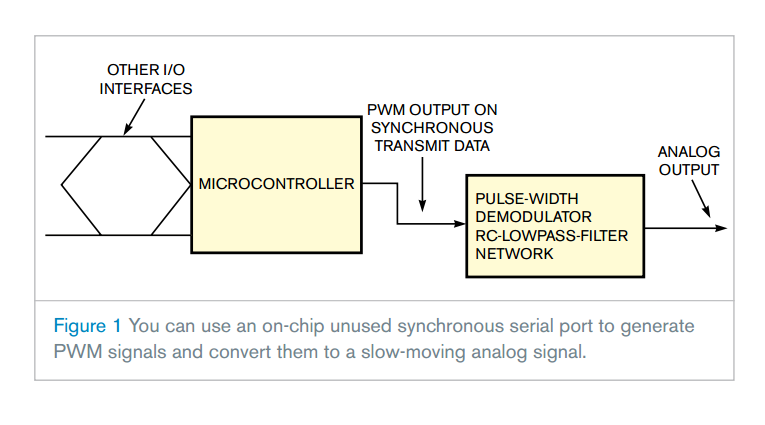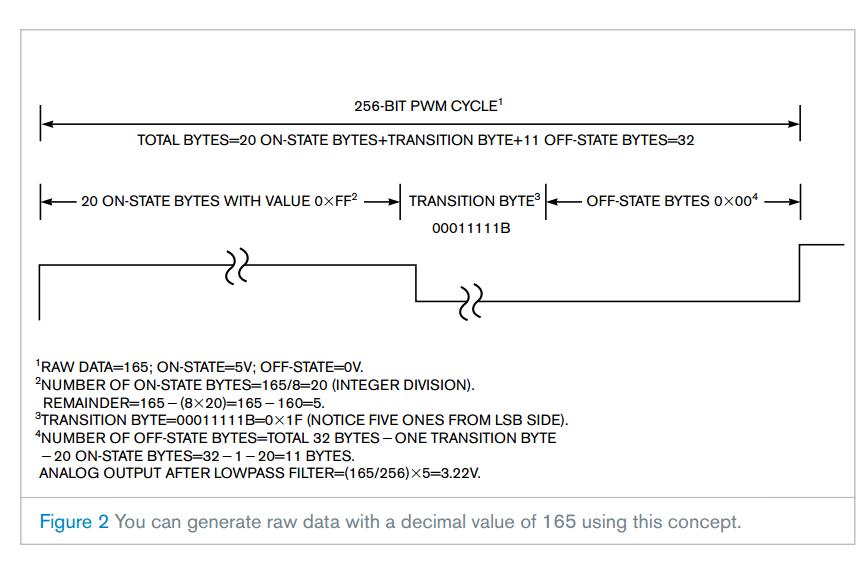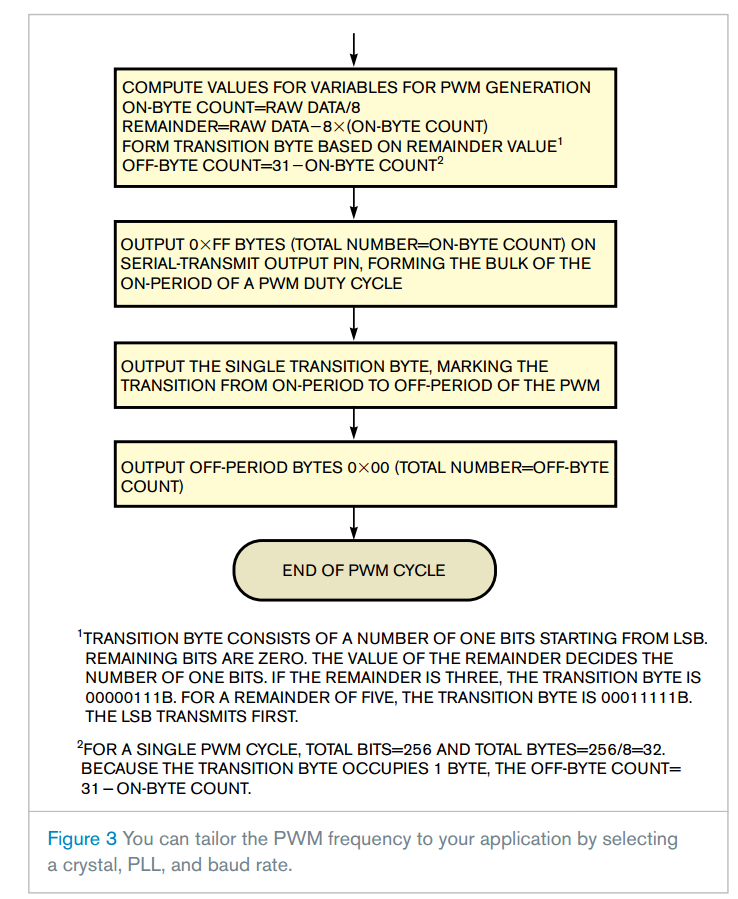Unused port adds a PWM/analog channel to a microcontroller
Low-cost, 8-bit, single-chip microcontrollers are stingy when it comes to on-chip PWM (pulse-width-modulation) resources. The use of a PWM resource often forces a designer to sacrifice a capture/compare or timer channel because the PWM channel shares the same on-chip hardware. This Design Idea describes how you can use an on-chip unused synchronous serial port to generate PWM signals and convert them to a slow-moving analog signal (Figure 1).

Many microcontroller-based stand-alone electronic units don’t use the synchronous serial port. Thus, you can use the microcontroller’s baud-rate generator and parallel-to-serial-converter blocks to generate bit patterns to form a 256-bit PWM pattern. You can then filter the PWM output with an RC filter to extract an analog signal (Reference 1). The synchronous communication is devoid of the start and stop bits of asynchronous mode, so the bit pattern can generate long periods of high or low level.
You can generate raw data with a decimal value of 165 using this concept (Figure 2).

A PWM-conversion cycle consists of generating 256 bits—that is, 32 bytes. The number of “on” bits corresponds to the value of the raw data to convert into PWM. Hence, for 165 bits as the raw data, 165 bits are on and 91 bits are off. To generate a 165-bit on-period, the first 20 bytes—that is, 160 bits—transmit as 0×ff on-state bytes. The trick lies in judiciously composing the 21st, or transition, byte. This byte has some of its LSBs (least significant bits) as ones and the rest as zeros to form the required length of the on-period. In this case, the circuit needs five more on bits: 160+5=165. Hence, the transition byte should have a 00011111b pattern (byte=0×1f).
Figure 3 illustrates the process in flow-chart form.

You can tailor the PWM frequency to your application by selecting a crystal, PLL (phase-locked loop), and baud rate. A simple RC filter can convert the PWM into a slow-moving analog value. Although this idea describes an 8-bit PWM, you can increase or decrease resolution by changing the total bits per PWM cycle. You correspondingly increase or decrease the conversion time.
Listing 1 provides a sample code for illustrating the concept. The code uses theMicrochip PIC18F4525, which has a 4-MHz crystal and 10-kHz baud rate for the synchronous serial communication, yielding 10,000/256=39.31 Hz of PWM frequency. You can filter it with a 0.1-sec RC filter, which is sufficient for slow-moving analog signals, such as speed setpoints for motion-control applications. By using a 20-MHz crystal, you can achieve synchronous serial baud rates greater than 1.5 MHz and PWM frequencies of a few kilohertz.
/*
This is a demo program from illustrating PWM generation using Synchronous Serial Port
Micro-controller for this code is 18F4525 Controller. however the code can be ported to any equivalent CPU
Date= 15/05/2009
Author: vishwas Vaidya Version 1.00 contains the code for outputting a byte on synchronous serial transmitter
Variable Raw_Data is output to synchronous transmitter Initialisations relevant for Synchronous Serial Communication
1.0 TRISC<6:7> = 1; PORT C FOR SERIAL COMMUNICATION.
2.0 SPEN = 1; .....RSCTA<7>
3.0 SPBRG = 0x64 ; For 4MHZ crystal Fosc/4x100 = 10 KHZ
4.0 TXSTA =0xBF ; CSRC = 1; TX9 = 0;TXEN = 1;SYNC = 1; b3,b2 = x;TRMT = i/p;TX9D = x
5.0 RCSTA =0x80 ; SPEN = 1; all other bits beind Rx related reset to zero.
Initialisations for Transmit Interrupt
1.0 Bit PEIE ..(INTCON <6>) = 1 FOR ENABLING PERIPHERAL INTERRUPTS
2.0 Bit TXIE .. (PIE1 <4> ) = 1
3.0 Ensure that GIE is set */ //Project includes //#include <pic18.h>
#include <p18f4525.h> //Project defines #define tmr1_reload_L 0x0A //Timer 1 reload values for 1ms timing, therotical = 0xFBE7
#define tmr1_reload_H 0xFC //fine tuned for RPM accuracy, practical = 0xFC0A //Global variables unsigned char timer_100ms; //system timer variables
unsigned char timer_500ms;
unsigned char timer_1000ms;
int timer_100ms_flag; //flag for 100ms timer unsigned char Tx_Byte; // Byte to be Transmitted in Tx interrupt //------Variables for DAC house Keeping and Start conversion Start
unsigned char RawData; //Input digital data to be converted into analog
unsigned char Next_On_Byte_Count; // Number of 0xFF bytes in on duty period of PWM for next DAC cycle
unsigned char Next_Off_Byte_Count;// Number of 0x00 bytes to be transmitted in off state
unsigned char Next_Transition_Byte; // Last byte in On duty period beffore off duty starts(for Next DAC cycle)
unsigned char Remainder; // Remainder of division of RawData by 32
//Look-up table for mapping remainder of RawData/32 for generation of "Transition byte"
//into number of '1's. e.g. remainder of 02 is mapped as 0x03 where number of ones are two. const unsigned char Transition_Byte_Array [] =
{0X00,0x01, 0x03, 0x7, 0x0F, 0x1F, 0x3F, 0x7F}; unsigned char On_Byte_Count; // Number of 0xFF bytes in on duty period of PWM for current DAC cycle
unsigned char Transition_Byte; // Last byte in On duty period beffore off duty starts for current DAC cycle //----Variables for DAC House Keeping end. //--------Variables for Transmit_Byte start--- int On_Period_Flag ; //On Period is in Progress ....... in 18f4525 defination as "bit" is not allow.
int Eoc_Flag ;//End of conversion flag
unsigned char DivisionData;//Debug division algorithm
unsigned char Off_Byte_Count; //Number of Off state bytes (0x00) during off period. int Get_Next_Byte_Flag ;// Indicates that TxByte contents should be updated for next byte interval //---------Variables for Transmit Byte end.
unsigned char New_RawData; //Function definations void controller_init (void)
{
//Ports configuration
TRISA = 0xFF; //PortA configured as input port
TRISB = 0xFF; //PortB configured as input port
TRISC = 0b11010010; //PortC configured for Serial Communication, RC2 as output pin for EGR output
TRISD = 0b11110000; //PortD lower nibble configured as output
TRISEbits.PSPMODE = ; //Parallel slave port mode disabled for PortD digital I/O operation //Debugging code for division
DivisionData = 0x08;
DivisionData = DivisionData * 0x15;
// DivisionData = 0xff/ DivisionData ; // Debug division algo
//ADC module configuration
ADCON0 = 0b00000001; //ADC clock as Fosc/8 and CH0 selected
ADCON1 = 0b00000000; //PortA configured as analog input pin
ADCON2 = 0b00000001; //oscilator frequency focs/8
PIE1bits.ADIE = ; //Disable ADC interrupt //SPI module configuration
PIE1bits.SSPIE = ; //SPI interrupt disabled
SSPSTAT = 0b00111111; //SPI module configuration
SSPCON1 = 0b00100001; // //Timer 1 configuration for 1ms interrupt generation
TMR1L = tmr1_reload_L; //Load timer for next cycle
TMR1H = tmr1_reload_H;
T1CON = 0b00000001; //1:1 prescaler, internal clock source, enable timer // USART configuration for Synchronus Communication SPBRG = 0x64 ; //For 4MHZ crystal Fosc/4x100 = 10 KHZ
TXSTA =0xBF ; //CSRC = 1; TX9 = 0;TXEN = 1;SYNC = 1; b3,b2 = x;TRMT = i/p;TX9D = x
RCSTA =0x80 ; //SPEN = 1; all other bits beind Rx related reset to zero. //Interrupts configuration
INTCONbits.GIE = ; //Global interrupt enable bit
INTCONbits.PEIE = ; //Peripheral interrupt enable bit
PIE1bits.TMR1IE = ; //enable timer 1 interrupt
INTCONbits.INT0IE = ; //Enable INT0 external interrupt
INTCON2bits.INTEDG0 = ; //INT interrupt configured for rising edge
PIE1bits.TXIE = ; // Enable Transmit Interrupt
INTCONbits.RBIF = ; //disable interrupt on portB pin change Tx_Byte = 0x0F; //Load Transmit Byte for first interrupt
} //void interrupt isr (void)
void isr (void)
{
//Timer 1 used to generate 1ms periodic interrupt.
if (PIR1bits.TMR1IF)
{
PIR1bits.TMR1IF = ; //clear interrupt flag TMR1L = tmr1_reload_L; //Reload timer for next cycle
TMR1H = tmr1_reload_H; if ( timer_100ms == )
{
timer_100ms = ; //reset 100ms_timer if 100msecs elapsed
timer_100ms_flag = ; //set timer flag
}
else
timer_100ms++; //else increment 100ms_timer
} if ( PIR1bits.TXIF)
{// Load transmit register with the byte to be transmitted TXREG = Tx_Byte ;
Get_Next_Byte_Flag = ; //Get next value of Tx_byte }
} void system_init (void)
{ timer_100ms = ; //initialise system timers
timer_500ms = ;
timer_1000ms = ; On_Period_Flag =; //Initial period in PWM is on state
Eoc_Flag =; // Assume conversion is over at the start
Tx_Byte = 0x3F ; // First byte is mostly all bits on
Get_Next_Byte_Flag =; } void system_timers_update (void)
{
timer_500ms++; //increment timer
if (timer_500ms == ) //reset timer every 0.5 second
timer_500ms = ; timer_1000ms++; //increment timer
if (timer_1000ms == ) //reset timer every 1 second
timer_1000ms = ;
} //Function for DAC House Keeping /* This routine takes RawData as input from the calling routine and works out PWM
on duty cycle period for the same. This period is specified as number of 0xFF bytes
(NextOnByteCount) followed by last byte (known as NextTransitionByte) to complete
the own "duty-cycle period". For example for Rawdata = 0x86 = 134 decimal
We should have 134 bits on and 122 bits off in 256 bit interval. To generate
134 bit on interval we can generate 16 bytes with value 0xff to give 128 bit on time giving
NextOnByteCount = 0x28 (40 Decimal). To complete remaining 6 bit interval out of 134 bit on time we should ouput
0x00111111b = 0x3F which gives first 6 bits as "1". Remember that shifting sequence is from lsb to msb. */
void DAC_House_Keeping (void) { Next_On_Byte_Count = RawData >> ; //RawDat/8 = number of on bytes with 0xff value
Remainder = RawData - (Next_On_Byte_Count << ) ; //Remainder indicates last byte in on period
Next_Transition_Byte = Transition_Byte_Array[Remainder]; //Map remainder into on bits.
Next_Off_Byte_Count = - Next_On_Byte_Count ; //OffByte +OnByte +TransitionByte = 32
}
//Function for Start of conversion
/*This routine is invoked when End_Of_Conversion is true(Eocflag) and new RawData is available for
conversion. The new Raw data is processed by the DAC_House_Keeping routine to generate
OnByteCount and TransitionByte for next cycle. These values are updated at the start of
every new conversion cycle. EocFlag is rest to mark "conversion in progress" condition
*/
void Start_DA_Conversion (void)
{ On_Period_Flag = ; //Initial perid of of PWM is on state
Tx_Byte = 0xff ;//First Byte will be 0x ff in most cases.
On_Byte_Count = Next_On_Byte_Count; // Set number of 0xff bytes during on duty
Off_Byte_Count = Next_Off_Byte_Count;//Set number of 0x00 bytes
Transition_Byte = Next_Transition_Byte; //Set the last byte at the transition from on to off
Eoc_Flag = ; // Conversion is in progress now.
}
//-----------------Comments for Transmit_Next_Byte Start---------------------------------------------
// Function for Byte Transmition on synchronous communication channel
/* This routine actually implements PWM on serial synchronous channel. It is invoked
every time the transmit interrupt submits a byte to the synchronous transmitter.
Get_Next_Byte_Flag triggers this routine The PWM cycle is logically divided into three segments, viz: On duty, transition and off duty.
The byte to be transmitted (TxByte)takes on three possible values depending on which segement
of the PWM cycle is currently in progress: 1.0 If on duty is in progress then TxByte = 0x ff
(THIS CONDITION is defined when OnBytecount >0 and On_Period_flag is set)
2.0 If "on to off" transition is in progress then TxByte = Transition_Byte
(This condition is defined when Onbyte count = 0 and On_Period_flag is set. Once
this condition is detected, transition byte is submitted for transmission and
On_Period_flag is reset. ) 3.0 If off duty is in progress then TxByte = 0x00 */ //--------------------------------Code for Transmit_Next_Byte Start----------------
void Transmit_Next_Byte (void) {
Get_Next_Byte_Flag = ;//Reset the flag set by Transmit ISR
if (On_Period_Flag)
{ // Onduty is in progress
if (On_Byte_Count > )
{
On_Byte_Count --;
}
else
{ //On_Byte_count = 0 implies no more 0x ff to be transmitted
if (!(Tx_Byte == Transition_Byte))
{
Tx_Byte = Transition_Byte;
}
// Transmit Transition_Byte if not already transmitted.
//However if Transition_Byte is transmitted last time
// then start off duty cycle
else
{
Tx_Byte = 0x00; // off state byte
On_Period_Flag = ;//On period ends
Off_Byte_Count--;// Start tracking off_bytes transmitted
} }
}
else
{
if (Off_Byte_Count > )
{
Off_Byte_Count --;
}
else
{
Eoc_Flag =;
} //If off_bytes have been all transmitted,
}
} //end the conversion cycle. //Main program
// this program illustrates how the "Software DAC chip" formed by sync. serial port can be used to convert digital raw-data
// into PWM/analog voltage. Actual application can be built by expanding this concept. void main (void)
{
controller_init (); //initialise controller
system_init (); //initialise global variables, timers & counters
New_RawData = 0xA5;
DivisionData = 0x05;
DivisionData = 0x01/ DivisionData ; // Debug division algo
while ()
{ New_RawData = 0xA5; //RawData = 165 Say. 5 On Bytes, TransitionByte=0x1f,Off Bytes=2. Actual application can contain code for generating the raw data corrosponding to the application. system_timers_update (); //system timer function if (timer_100ms_flag) { timer_100ms_flag = ;
RawData = New_RawData; //update Raw Data
DAC_House_Keeping (); //Prepare for next conversion cycle
} // Keep converting the RawData from digital to analog if (Eoc_Flag) Start_DA_Conversion ();//Start at EOC rising edge converting
if (Get_Next_Byte_Flag) Transmit_Next_Byte();//Keep transmitting on serial line
}
}
Unused port adds a PWM/analog channel to a microcontroller的更多相关文章
- How to do SSH Tunneling (Port Forwarding)
How to do SSH Tunneling (Port Forwarding) In this post we will see how ssh works?, what is SSH tunne ...
- PWM DAC vs. Standalone
http://analogtalk.com/?p=534 http://analogtalk.com/?p=551 Posted by AnalogAdvocate on April 09, 2010 ...
- M451 PWM对照数据手册分析
PWM_T Struct Reference Control Register » Pulse Width Modulation Controller(PWM) typedef struct { ...
- 说说M451例程之PWM的寄存器讲解
M451提供了两路PWM发生器.每路PWM支持6通道PWM输出或输入捕捉.有一个12位的预分频器把时钟源分频后输入给16位的计数器,另外还有一个16位的比较器.PWM计数器支持向上,向下,上下计数方式 ...
- 图解再谈ssh port forwarding-ssh隧道技术
https://www.ramkitech.com/2012/04/how-to-do-ssh-tunneling-port-forwarding.html https://www.cnblogs.c ...
- 【DM642学习笔记六】TI参考文档--DM642 Video Port Mini Driver
这个文档介绍了在DM642EVM板上视频采集和显示微驱动的使用和设计.用EDMA进行存储器和视频端口的数据传输.为了增强代码的复用性和简化设计过程,驱动分为通用视频端口层和特定编解码芯片微驱动层两个 ...
- Keil MDK STM32系列(七) STM32F4基于HAL的PWM和定时器
Keil MDK STM32系列 Keil MDK STM32系列(一) 基于标准外设库SPL的STM32F103开发 Keil MDK STM32系列(二) 基于标准外设库SPL的STM32F401 ...
- Keil MDK STM32系列(八) STM32F4基于HAL的PWM和定时器输出音频
Keil MDK STM32系列 Keil MDK STM32系列(一) 基于标准外设库SPL的STM32F103开发 Keil MDK STM32系列(二) 基于标准外设库SPL的STM32F401 ...
- Serial Port Programming on Linux(转载)
This is a tutorial on how to program the Serial Ports on your Linux box.Serial Ports are nice little ...
随机推荐
- Spring 控制台运行及RestTemplate实现Eurka负载均衡
spring使用控制台运行方式 spring.main.web-application-type=none新老版本的配置有点差异 Maven的modules只是实现了一个顺序编译,一次多个项目一起生成 ...
- KM bfs写法
KM bfs写法 2018astar资格赛的第三题整数规划. 把\(x, y\)看成二分图两边的顶标,\(a_{ij}\)就是二分图的边权,整道题其实就是求二分图的最大权匹配. 然后打了个\(dfs\ ...
- 003_循环(loop), 递归(recursion), 遍历(traversal), 迭代(iterate)的区别
表示“重复”这个含义的词有很多, 比如循环(loop), 递归(recursion), 遍历(traversal), 迭代(iterate). 循环算是最基础的概念, 凡是重复执行一段代码, 都可以称 ...
- fprintf输出到文件中,sprintf输出到字符串中. 如: fprintf(fp,"%s",name); fp为文件指针 sprintf(buff,"%s",name); buff为字符数组
fprintf输出到文件中,sprintf输出到字符串中. 如: fprintf(fp,"%s",name); fp为文件指针 sprintf(buff,"%s" ...
- 交通运输线(LCA)
题目大意: 战后有很多城市被严重破坏,我们需要重建城市.然而,有些建设材料只能在某些地方产生.因此,我们必须通过城市交通,来运送这些材料的城市.由于大部分道路已经在战争期间完全遭到破坏,可能有两个城市 ...
- 20165301 2017-2018-2 《Java程序设计》第二周学习总结
20165301 2017-2018-2 <Java程序设计>第二周学习总结 教材学习内容总结 第二章:基本数据类型与数组 标识符 第一个字符不能是数字 不能是关键字 不能是true.fa ...
- 7. Docker Compose 项目
- java IntelliJ IDEA 13 注册码 IDEA序列号 License Key
java IntelliJ IDEA 13 注册码 IDEA序列号 License Key Username: JavaDeveloper@sskaje.me License: 282971-M1NW ...
- CSS3中的矩阵
CSS3中的矩阵 CSS3中的矩阵指的是一个方法,书写为matrix()和matrix3d(),前者是元素2D平面的移动变换(transform),后者则是3D变换.2D变换矩阵为3*3,如下面矩阵示 ...
- WordPress 用户管理插件 WP User Manager
WP User Manager 是一个较新的用户管理插件,可以在前端实现 用户注册.登录.找回密码.修改个人资料.修改密码等功能,如果你在找这方面的插件,WP User Manager 应该是一个不错 ...
